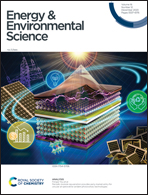In situ polymerization of 1,3-dioxane as a highly compatible polymer electrolyte to enable the stable operation of 4.5 V Li-metal batteries†
Abstract
1,3-Dioxolane (DOL) has received great attention as a polymer electrolyte (PE) for Li-metal batteries (LMBs) due to its desirable interfacial contact and decent compatibility with Li-metal, yet it suffers from poor oxidation stability, thus making it inadequate for high-voltage cathodes. Herein, by tuning the molecular structure of the liquid precursor from being a five-membered cyclic DOL to a six-membered cyclic 1,3-dioxane (DOX), the in situ fabricated poly(DOX) PE obtained exhibits superior oxidation stability (exceeding 4.7 V) owing to its prolonged alky chain that lowers its HOMO level. Moreover, the prolonged alky chain also weakens its solvating ability, which not only affords a high Li+ transference number (0.75), but also contributes to a highly robust and conductive inorganic-rich solid–electrolyte interphase, bestowing highly dense Li deposition morphology as well as excellent Li plating/stripping reversibility for over 1300 h. As a result, this newly developed poly(DOX) PE delivers outstanding cycling stability for diversified high-voltage cathodes including but not limited to LiNi0.33Co0.33Mn0.33O2, LiNi0.8Co0.1Mn0.1O2, and LiCoO2 under a high cut-off voltage of 4.5 V, paving the way for the practical application of high-voltage high-energy-density solid-state batteries.



 Please wait while we load your content...
Please wait while we load your content...